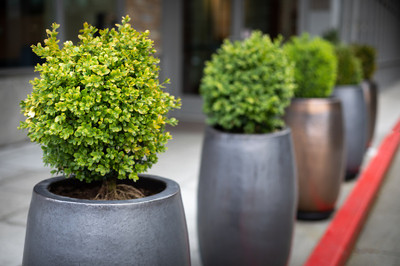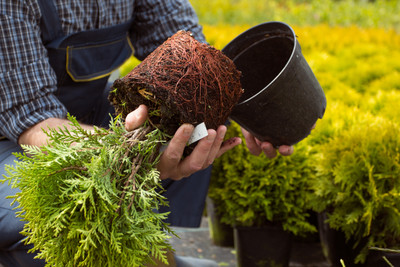Transform Your Driveway with These Stylish Border Landscape Ideas
Posted by Jason Wyrwicz on Oct 1st 2025
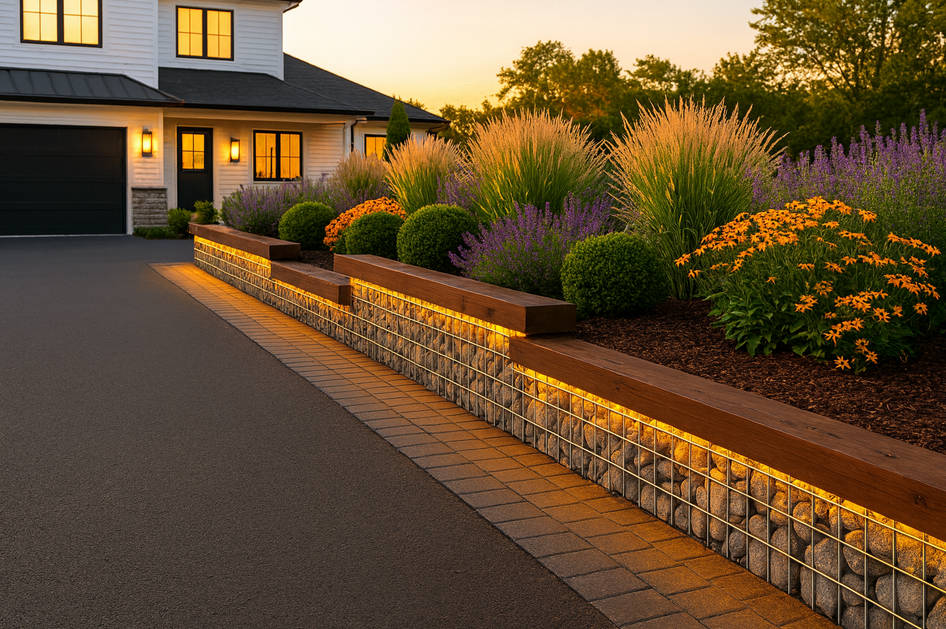
A driveway eats up a surprising slice of your front-yard real estate, yet many homes leave that strip bare. If you swap that raw edge for a thoughtful border, your entire entrance transforms into a signature statement.
Stone soldiers, low evergreens, slender steel, each option frames the house, guides turning wheels, and reduces weekly cleanup.
This guide offers landscape ideas for driveway borders, moving from hands-on advice to concrete steps you can implement over a single weekend or in phases through the season.
You'll find clear material comparisons, fresh design inspiration, plant pairings that stay lively in heat and frost, and practical build tips that keep budgets tidy.
Why Driveway Borders Matter
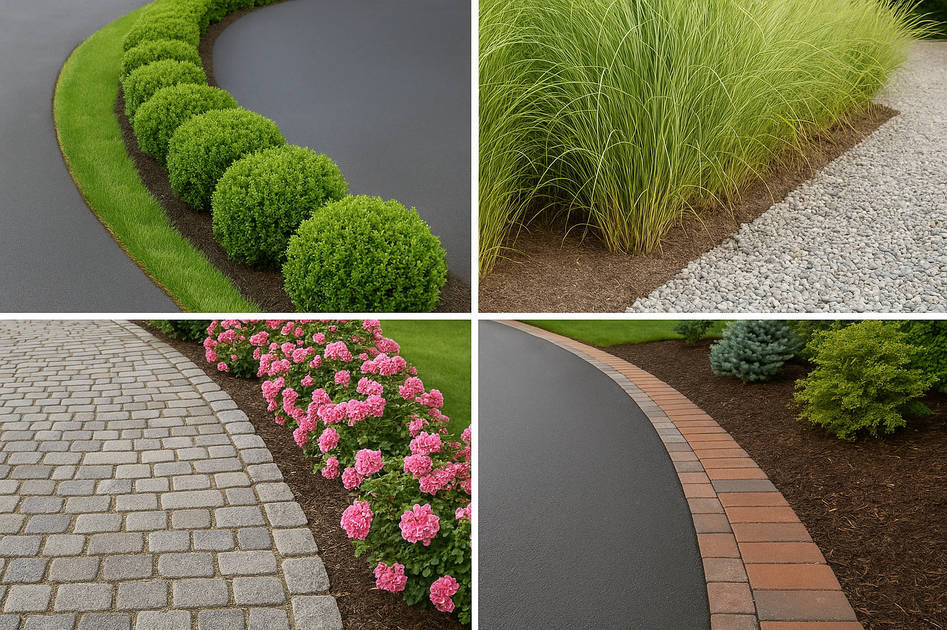
First off, a clean border keeps loose gravel and mulch where they belong, inside the driveway line, so you sweep a lot less. Raised edging also blocks rushing rainwater, which means the soil stays in place instead of streaking across the pavement.
Add a clear visual cue along the edge, and drivers steer true, keeping lawn corners intact without ruts or torn turf. That crisp outline shows visible care, which real estate pros convert into higher appraisals.
On top of that, sturdy materials cut long-term costs. Brick, stone, or steel shrug off freeze-thaw cycles and tire scuffs much longer than a bare strip of grass.
Meanwhile, a row of drought-tough plants drinks runoff, feeds pollinators, and shortens mowing sessions because the deck no longer has to hug the pavement. Fewer trim passes translate into lower fuel bills and more weekend time to relax.
Materials & Plant Options
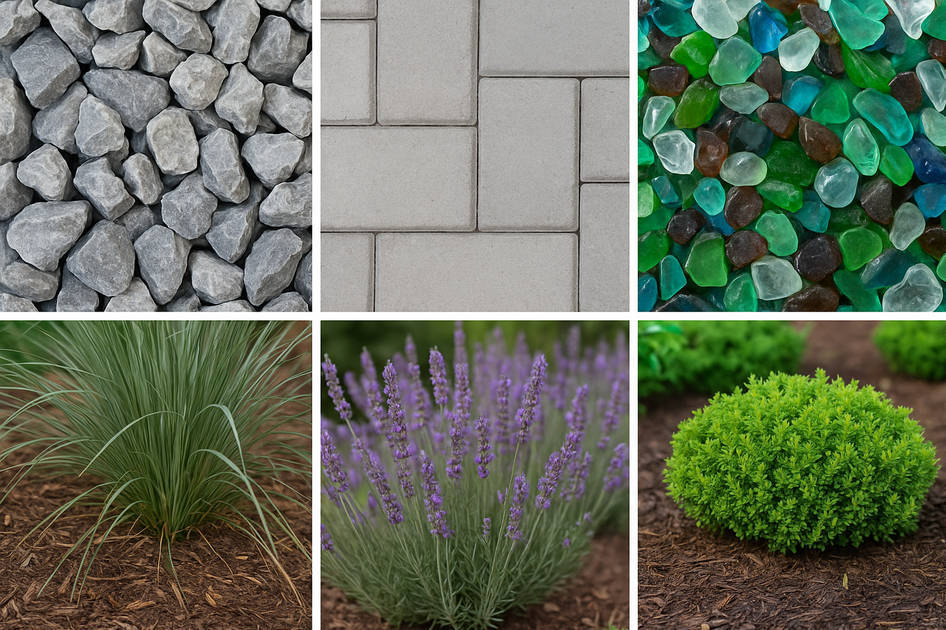
Choosing the right border starts with purpose. In areas with heavy freezes, you’ll want materials that hold up against freeze-thaw cycles. Coastal properties need options that resist salt spray and storm surges. Tropical gardens call for solutions that shrug off mildew and constant moisture.
Here's a breakdown of the materials and plant borders.
|
Material / Plant |
Pros |
Cons |
Best Fit |
|
Stone or Cobblestone |
Beefy, stands up to plows and de-icer, ages gracefully |
Labor-intensive, higher price point |
Heritage homes, grand entries |
|
Steel Edging |
Slim profile, bends into fluid curves, easy to conceal drip lines behind |
Surface rust can stain light-colored concrete |
Modern architecture, minimalist gardens |
|
Concrete Curbing |
Custom shapes, pigment options, integral strength |
Requires a curb machine or a skilled crew |
Wide drives, commercial or busy households |
|
Reclaimed Timber |
Warm texture, eco-friendly, simple to cut and replace |
Needs periodic sealing, risk of rot |
Cottage façades, rustic acreage |
|
Brick or Pavers |
Endless laying patterns, individual repairs possible |
Takes time to place and level |
Classic suburban streets, mixed hardscape |
|
Plastic or Recycled Rubber |
Lightweight, budget-wise, ideal for DIYers |
Fade risk, less rigid over very long runs |
Rental properties, fast weekend projects |
|
Layered Systems |
Hidden structural layer plus decorative capstone handles load and looks good |
Two-step install adds complexity |
Steep slopes, heavy rainfall corridors |
|
Live Plant Borders |
Natural texture, seasonal change, pollinator boon |
Requires irrigation and trimming |
Garden-focused properties, mild climates |
Modern & Stylish Border Inspirations
Stylish borders don’t stick to one formula; they borrow smart ideas that fit the house, climate, and traffic pattern. Below are expert-backed concepts you can adapt on a weekend or spread across a season.
Gabion Stone Walls
What It Is: These are knee-high walls made from wire-mesh cages packed with river rock. The hefty mass shrugs off tire scuffs, and the open structure lets rain drain right through.
Best Use: Great for hillside entries or rustic façades, as they stop soil creep on slopes. For impact, add a hidden LED strip behind the mesh to create a glowing ribbon after dark.
Corten Steel Plates
What It Is: Thin sheets of weathering steel that sit flush with the turf. The material starts pale but settles into a warm copper tone over time.
Best Use: Ideal for minimalist layouts and drought-tolerant yards. Mower wheels glide right over the surface, providing a crisp, durable line that pairs well with cedar siding and black trim.
Grass Ribbons Between Pads
What It Is: Large concrete pads separated by five-inch bands of turf or creeping thyme. This system softens hard edges, keeps the pavement cooler, and soaks up runoff.
Best Use: Use them for a softer edge on modern driveways. Trim the green stripes with a string trimmer once a week, and consider adding flat stepping stones near passenger doors for dry exits.
Layered Edging Systems
What It Is: A two-part system where a hidden plastic bender board locks base gravel in place, and a brick soldier course on top adds aesthetic finish. It's muscle below, charm above.
Best Use: This robust setup handles heavy storms and fits cottage, colonial, or Craftsman-style homes that benefit from traditional materials.
Rock Trenches (French Drains)
What It Is: A six-inch trench filled with mixed river stone that runs beside the drive. It channels water away into a dry well or rain garden.
Best Use: Perfect for entries that take on frequent downpours yet need a softer, natural accent. Larger stones sit low for flow; smaller pebbles finish the surface for easy foot traffic.
Permeable Glass Pavers
What It Is: Recycled glass blocks set in permeable mortar create a shimmering twelve-inch border that filters stormwater through the joints.
Best Use: The subtle sparkle pairs well with contemporary architecture and coastal settings where a full concrete slab might glare too much.
Stamped Concrete Banding
What It Is: A refined finish created by pouring a one-foot outer band, pressing in a slate or reclaimed-wood texture, and tinting it two shades deeper than the main slab.
Best Use: Ideal for wide suburban drives seeking a refined upgrade. The continuous pour survives snow shovels and plows while framing the driveway like architectural trim.
Plant-Based Border Enhancements
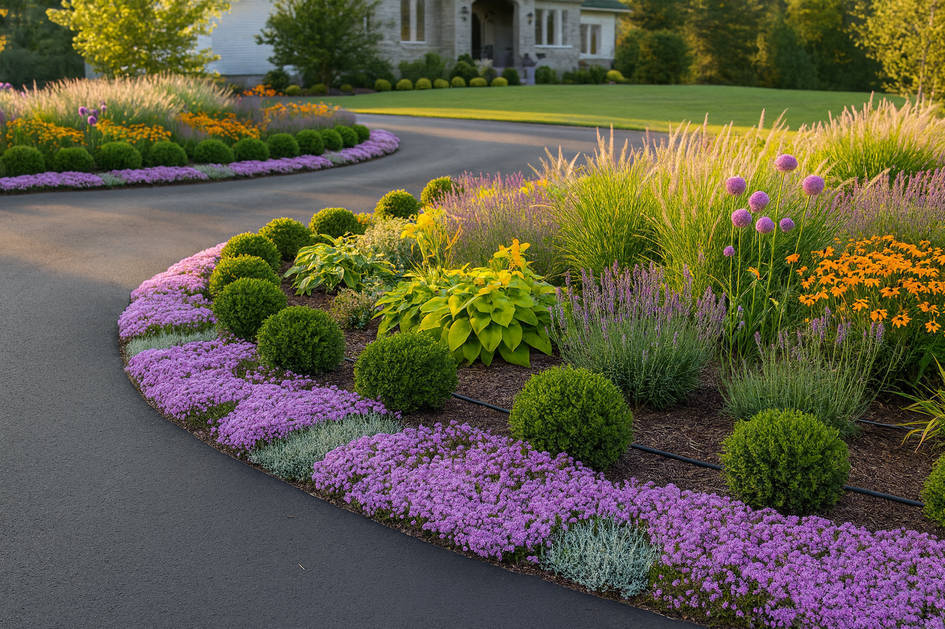
Plants lend movement and year-round color while softening hard edges.
To begin, start at the pavement with a neat, low band that sets the structure. Creeping phlox or woolly thyme forms a living carpet only two inches tall, so tires stay clear and the mower glides past without trimming headaches. Both choices spread slowly, filling gaps and spilling a hint of bloom each spring.
Step back a foot and plant a repeating backbone. Dwarf boxwood spheres or blue oat grass give the line a steady rhythm that reads well from the street. Boxwood holds glossy green through winter, while blue oat grass keeps icy steel tones that echo concrete or pale gravel.
Behind that evergreen band, slip in mid-height color. Daylily ‘Happy Returns’ pumps out lemon blooms all summer with minimal deadheading. Lavender ‘Hidcote’ adds fragrance and silvery foliage that pairs easily with stone or steel edging. In shadier spots, hosta ‘Halcyon’ and Japanese painted fern supply lush texture without begging for sunlight.
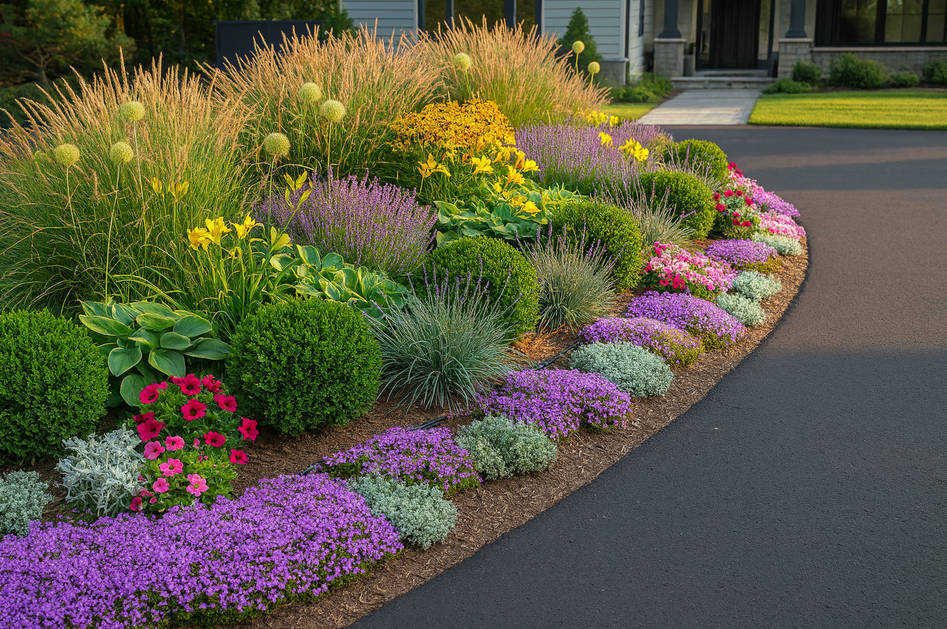
Tall accents finish the depth. Switchgrass ‘Northwind’ delivers upright blades that sway in a breeze, catching headlights at dusk. Rudbeckia ‘Goldsturm’ or ornamental allium shoot cheerful seed heads above the rest, drawing the eye upward and adding late-season punch.
Tuck a few quick-change annuals, petunias, calibrachoa, or dusty miller, into open pockets for instant splash while perennials root in. Mulch with fine bark to lock moisture, then run drip tubing under foliage so watering stays hands-off. The result: a layered, drought-tough border that cuts mowing time, feeds pollinators, and frames the driveway with living color all year.
Practical Considerations
Before ordering stone or staking out trenches, run through these practical checks. They’ll keep the border looking sharp and working hard long after the last brick is set.
- Drainage & permeability: Let rain soak in instead of racing to the gutter. Permeable pavers, shallow rock swales, or narrow grass strips between concrete pads give water an easy path underground. The driveway edge stays dry, and nearby beds get a slow, steady drink.
- Containing gravel: Loose stone loves to migrate under spinning tires. A slim steel or aluminum strip sunk level with the surface pins gravel in place. For a softer look, tuck a brick soldier course at grade.
- Layout and access: Before digging, park the widest vehicle you own and turn the wheels full lock. Mark that swing arc, then keep the new border at least six inches outside that line. Garage doors open cleanly, bumpers stay scuff-free, and guests won’t clip a corner.
- Electrical & future-proofing: Always slide an empty PVC conduit beside the new edging while the trench is open. This simple step creates a permanent, protected channel. You can pull low-voltage lighting wire or even an EV-charger cable through it later, all without digging up the finished hardscape. Cap both ends to keep soil and critters out until you are ready to wire.
- Maintenance: Stick with drought-tough plants, lavender, sedum, blue oat grass, or go for materials that need almost no upkeep, like Corten steel or stamped concrete. A quick spring check for loose stakes or stray weeds is all the attention the border should need.
Creating a Cohesive Entry
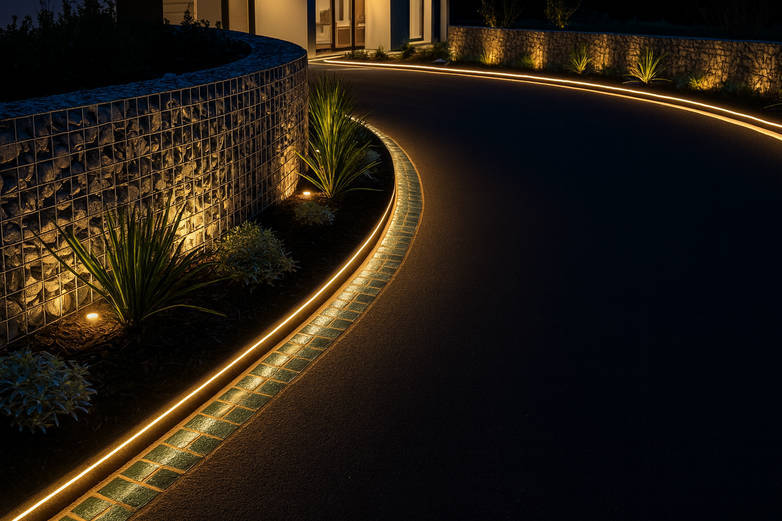
A driveway border doesn’t stand alone; it works best when every front-of-house detail feels connected. Keep these pointers in mind to pull the whole scene together.
- Lighting integration: Slip low-voltage tape lights into gabion cavities, tuck puck lights under concrete capstones, or recess mini LEDs along a timber edge. Subtle illumination guides night-time parking, highlights texture, and adds a gentle glow without cluttering the sightline with extra fixtures.
- Coordinating with gates, fences, or façade: A steel edging strip mirrors a wrought-iron gate. A reclaimed-timber border echoes a cedar fence. A row of clay pavers ties back to a brick porch column. By using the same material or color palette, you connect separate parts of your home into one cohesive design.
- Matching finishes for unity: For a cohesive look, let your border pick up cues from the house itself. For example, Corten plates can share the warm rust tone of copper gutters, while slate-tinted stamped concrete bands relate visually to dark-charcoal roof shingles.
Similarly, limestone rock used in a French drain can match light stone window sills. When these finishes talk to one another, the entire driveway feels purpose-built rather than just tacked on.
DIY Planning & Visual Tools
A clear plan spares return trips to the store and keeps the build on budget. Follow this simple roadmap before moving a single shovel of soil.
Step 1: Measure the entire driveway perimeter with a tape or measuring wheel, then add ten percent for cuts and curves.
Step 2: Pick a style that matches the house, like natural, modern, or traditional, and stick to that theme across all edges.
Step 3: Lock in one primary material or plant palette that complements existing hardscape or siding.
Step 4: Check climate, traffic volume, and available weekend hours to confirm the choice fits maintenance goals.
Step 5: Sketch the layout on grid paper or overlay lines on a driveway photo in a phone app.
Step 6: Mark spots for drainage swales, conduit runs, and low-voltage lights before breaking ground.
Step 7: Add a top layer for polish: path lights, layered edging, or matching planters at the garage.
Planning checklist
- Driveway length recorded with a ten-percent buffer
- Style theme chosen
- Primary material or plant palette set
- Climate, budget, and upkeep needs reviewed
- Drainage path mapped
- Lighting and conduit plotted
- Layered edge or accent feature noted
Pro Tip: A shallow swale lined with river rock handles drainage and doubles as a design stripe; two jobs, one trench.
In Summary
A well-planned border does more than just frame the driveway; it keeps gravel corralled, guides turning wheels, and adds fresh character the moment someone pulls up. Think of it as curb appeal you can actually put to work.
The secret is blending sturdy hardscape with drought-savvy plants and tucking in some low-key lighting. Echo those materials in a few matching planters, and the result is a design that feels personal, fits the climate, and spares you extra yard chores down the road.
When you're ready to add those finishing touches, check out our planters and pick the pieces that complete the look.


